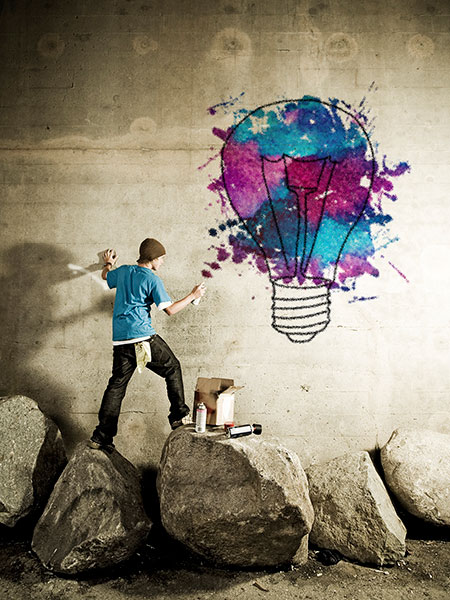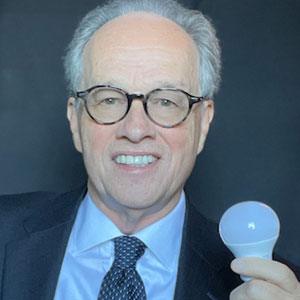 By Mark Lien
By Mark Lien
On my nightstand sits a circadian light. Its color changes to warm as the intensity automatically lowers over time to promote my peaceful transition to dreamland. It is unique, attractive, well-made and works just by turning it over on its small charging base. This activates the program with no connectors, buttons or switches. A friend told me about it during dinner at LIGHTFAIR this year. It is not made by a lighting company; it is branded by Casper, the mattress manufacturer. Why did this come from outside of our industry? Is it an isolated situation or another example of how are we losing the quest for lighting innovation?
The IES Progress Report is prepared by the only committee tasked with reporting on advancements to the art and science of lighting every year. They have been conscientiously doing this since 1911. Since the report is based on technology released during the previous year, it charts our path. At the Annual Conference in November the Progress Committee recognized three new health-related lighting luminaires from lighting manufacturers. A few minutes on Amazon reveals hundreds of “healthy” lighting products. A Google search of “healthy light bulbs” yields over 2,000 mostly relevant returns. Most of the products are from companies unfamiliar to me and I have been at most LIGHTFAIRS, specified lighting on hundreds of projects and served on the Progress Committee for almost 30 years. It is evident that most of these products are coming from outside of our industry. Similarly, a search for “smart lighting” reveals over 50,000, most of which are made and sold by companies not showing at LIGHTFAIR. How did this disconnect occur?
LIGHTING MANUFACTURERS HAVE EVOLVED into tech companies, at least that is their message. However, at the largest tech show, the Consumer Electronics Show (CES), the influence of today’s large lighting companies is almost invisible. There is a stratification between exhibitors at the CES and LIGHTFAIR with little overlap. The scale of CES dwarfs lighting events. CES claims more than 4,500 exhibiting companies, including manufacturers, developers and suppliers of consumer technology hardware, content and more than 250 conference sessions. The world’s largest lighting event, Light + Building, features about 2,700 exhibitors. LIGHTFAIR has about 500 but is more narrowly focused on the architectural lighting community. The disconnect between CES and LFI is conspicuous in both scale and for having unique lighting exhibitors.
Maybe the lighting industry is still evolving? Perhaps, but evolution passes by anything that does not change quickly enough or offer some unique advantage for survival. LFI is 30 years old. CES is over 50. What will LFI look like at 50? People will still need lighting, but most people outside of our industry could not name more than a few lighting companies (and those names they are familiar with like Philips, Sylvania and GE Lighting have changed). That means there is little lighting brand loyalty from most consumers. Lighting products are sold on features and aesthetics. New companies will meet with little resistance from consumers on these products as long as the features align with the trends consumers want at the price they are willing to pay.
Current lighting trends are toward miniaturization, automation and healthy light. As products shrink, they more easily assimilate into the infrastructure of buildings and other products. Automation is the end-game for the connected/smart trend so that our electrical products learn our preferences, adapt and operate with minimal effort from us. Healthy lighting, once we substantiate what it is in terms of duration, intensity and spectrum for categories of the population, will explode into the marketplace as consumers demand it in their homes and workspaces. Where do we see these three trends presented? Both LFI and CES address them in their exhibit hall and by the speakers they select (over 1,000 speakers were at the 2019 CES).
Sensors are an integral part of each of these trends. Both shows feature sensors but typically from different exhibitors. How will we automate our electrical products? That trend is the voice activated precursors to artificial intelligence. These assistants include Alexa, her less intelligent sister, Siri, and Google Home. Note that Amazon, Apple and Google do not show at LIGHTFAIR (yet?).
CES exhibitors include telecoms, Internet and electronics (TIEs) companies. LIGHTFAIR has seen a few large electronics companies rent booth space including Samsung, LG and Panasonic. Those three also exhibit at CES along with Verizon who is promoting their “Intelligent Lighting Platform.” The other large telecom, AT&T, also shows at CES. The AT&T smart cities initiative uses the tagline “from streetlights to bridges.” Amazon and Google exhibit at CES and both are invested in lighting. The electronics companies have a strong presence at CES, including Samsung, LG, Panasonic and Sony. They all offer lighting products as a part of their growing portfolios.
THE QUICKEST WAY THESE COMPANIES can grow every year to satisfy shareholders is through acquisition. Organic product development has a long learning curve. While the largest lighting companies strive to make a few billion dollars annually, Samsung’s 2018 revenue was over $73 billion. Entry into the lighting community is relatively inexpensive for them. LEDs have made lighting appealing as an option for integrating into other products as it can add a feature. A great example of this is with smart poles in smart cities. A purchaser could order the poles with a variety of sensors, drone and vehicle chargers, Wi-Fi or Bluetooth hardware, and banner connections. If that purchaser wants lighting on some of those poles, that option can be selected. Lighting would be relegated to being one of many options, not a stand-alone product. Disintermediation trends indicate that the lighting supplier would be selected by whoever makes or sells the smart pole, further jeopardizing existing luminaire suppliers that continue to market stand-alone lighting fixtures.
A quick review of the CES exhibitor list is telling. Circadian products along with lighting sensor and controls companies are present, many of which are not at LFI. Johnson Control and Honeywell, also involved in lighting installations, both show at CES. Some large Chinese manufacturers choose CES over LFI (assuming they are aware of LFI).
LFI does serve a valuable function that would get lost at CES. It, in addition to being a trade show and provider of education, fosters unprecedented networking opportunities for the lighting community. The scale and diversity of products at CES precludes this ability to renew, maintain and build new relationships directly related to our lighting careers and interests.
Will LFI and CES merge? No. Will they both change? Yes. Will the TIE companies buy more lighting companies? Yes. Will the large lighting manufacturers survive being assimilated? It is too soon to tell, but as my Magic 8 ball app often says, “Outlook not so good.” Either way, I will sleep well thanks to my Casper circadian light and mattress.

